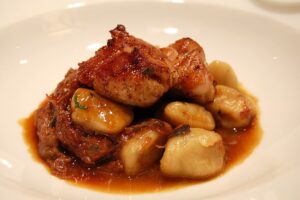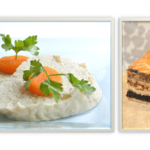Chopped liver is peculiar. I don’t mean that word using its somewhat negative connotations. I mean to use its denotative meanings of distinctive, special, and particular. In this post, I want to explain what is different about chopped liver within the Jewish Food canon, and also explore potential reasons for that peculiarity.
I wrote about this topic once in my newletter, about six months ago, and it was the one that generated the most responses from my readers, indicating that people feel strongly about their chopped liver! I had some initial thoughts there, but I want to dig deeper here, especially in reaction to those many responses. I also discussed it with Jeffrey Yoskowitz for an upcoming episode of my podcast. (Each podcast episode includes a short interview, but they are edited down from a longer interview I conduct, to end up at 5-7 minutes, and Jeffrey’s interview was long and had so much good material about chopped liver in it, that I suspect this bit will not make the final edit anyway. So why not discuss it in greater detail here?)
What’s the Deal With Chopped Liver?
There are a few elements to this dish that make it stand out. For starters, it is an organ meat, rather than muscular, which thus places it within the category of what is known as offal, aka “variety meats.” These foods historically have held a significant place in our cuisine, with Jews from around the world eating almost all edible parts of an animal upon its slaughter. That alone is not remotely peculiar.
But one oddity that I’ve noticed is that while most types of offal are no longer commonly eaten, chopped liver still is. I don’t mean to suggest that no one eats the many other offal dishes. All are still consumed to varying degrees in different parts of the world. Here in Israel, for example, virtually all of the organ meats are readily available and sold in butchers, and many find their way onto the menus at restaurants. But even those are somewhat less common today than they once were, I’d argue. Still, in places like America and the UK (where most of my readers are), and in many other places, most organ meats have fallen out of favor and are typically not eaten anymore. But even after people stopped eating calf spleens, lamb brains, or turkey testicles, for some reason they kept eating chopped liver, with some passionately praising it as a delicacy.

Further highlighting liver’s distinction, if we look at the cuisine of North African and Middle Eastern Jews, many organ meats remain popular. Common dishes include stuffed spleen, intestines, or tripe, for example. But while liver may have sometimes been included there as part of the stuffing for those foods, I have not come across any mentions of liver as a dish of its own within those communities. So why would it be so popular among Ashkenazi Jews, but not (by itself) for those of North Africa and the Middle East?
Finally, further cementing chopped liver’s uniquely iconic status, it is the only offal dish that I can think of that people make imitation versions of! I have not found “mock tongue” or “imitation ox tail.” Its beloved place in the American Jewish kitchen is so important that it has even become part of our idiomatic lexicon. You never hear anyone say, “What am I, p’tcha?!”
Well, How Did We Get Here?
The most common response I received to that newsletter came from chopped liver devotees who claimed that the reason chopped liver stayed popular despite the declining fortunes of so many other offal dishes was simply that “it tastes delicious.” To some degree, they stressed this point because I had mentioned that I am not a fan of the dish, even though I do like many other types of organ meats (i.e. I’m not grossed out by offal, I simply don’t like this type). And while I can’t argue with this opinion (there is no arguing with taste), it does not hold water for me as an explanation. Taste is subjective. Just as there are many who passionately love chopped liver, there are many others who hate it, or are indifferent to it. Similarly, I am certain there were many people who would make that same claim about lungen (cow lung stew) or miltz (spleen). So some people’s devotion to chopped liver does not seem sufficient to explain why it remains as a popular offal dish while the others have gone the way of Roman garum.
I think the explanation relates to a number of elements, combining to create a perfect storm of sorts. For starters, it is difficult to underestimate the French connection. Pâté de fois gras is recognized as the logical precursor to Ashkenazi chopped liver. Yoskowitz points out that Ashkenazi Jews probably made their chopped liver with goose liver more than chicken originally, as goose schmaltz was also preferred. But with chickens becoming more popular than geese for numerous reasons, the liver as well as the schmaltz of the chicken became more common. And Jews were very familiar with foie gras, as in Alsace (original Ashkenaz), Jews there were among the experts in its creation. They fattened geese to increase the amount of schmaltz produced, rather than to create a separate delicacy, and likely sold the livers to non-Jewish French people once it became a popular delicacy and could command a high price.
Still, Yoskowitz thinks the French aspect may be even more significant. French cuisine, particularly in mid-to-late-20th century America, was always seen as the classiest and fanciest food there was. And as he says, “If the American Jews were anything, they were aspirational.” So the fact that there was a classic Ashkenazi dish that was remotely like an extremely popular and famous French delicacy made it something that American Jews could eat, and do so proudly.

This might also explain another interesting aspect of chopped liver. A friend of mine wondered why it is that of all of the Jewish-American staples, chopped liver is one of the few that is called by its English name, rather than a Yiddish or Hebrew name like challah, kishke, gefilte fish, knish, kugel, or chulent. While some of those certainly were also on deli menus, the fact that we usually call it by its English name rather than gehakte leber may have been a way of bringing it to a broader American audience. We see the same thing in anotehr popular deli food; you order “chicken soup with matzo balls” rather than goldene yoich mit kneidlach.
Another factor that might both explain chopped liver’s popularity as well as its lesser popularity among North African and Middle Eastern Jews stems from the original reason we encountered it. Across the colder regions of Europe, schmaltz was the primary cooking fat. In warmer areas around the Mediterranean and further east, olive oil was most commonly used. So if you aren’t fattening your poultry to get more schmaltz, the liver will also be smaller. Furthermore, for those who are eating more poultry (since slaughtering the bird is the only way to access the fat for cooking), poultry offal will be more commonly eaten. (In North Africa, lamb was a more commonly eaten meat than was chicken.) And of all of the organ meats in a chicken, the liver is pretty much the only one of any decent size. So while one might also eat the other small organs, they would often be combined into a collective group of “giblets.” Yes, liver is often included in that, but if any of them is going to be pulled out to be prepared separately, the liver is the most likely candidate.
In essence, I believe that the explanation for chopped liver’s persistence as an Ashkenazi delicacy in America (and around the world) combines its place in Europe where it was the by-product of creating a cooking medium with the special elements of American Jewish life (i.e. upward mobility, the American deli, etc.). Solidifying its place is the fact that it also was a member of the holiday table (for Shabbat and particularly for Passover), which Yoskowitz points out was a contributing factor in the canonization of American-Jewish cuisine.
What is This Post, Chopped Liver? Pass it On!







Stuart Howard Borken
Joel Haber; I’m 83 years old but when I was younger and we had teenage kids we hosted Israeli Scouts and one was Dadi Haberfield. Your name is probably a derivative. Anyway, I make chopped liver which looks 100% like your photo. Nobody in the family makes it, only me. I also make the New York Style Caraway Onion Rye Bread to go with it. When I go, nobody wants to have learned how to make either one of the two classics. I make 6-7 pounds of chopped liver for the holidays and for Thanksgiving. I render my own schmaltz and make my schmaltz onions to help season the chopped liver. When I go, the making of the dish goes. I have recorded it on my recipe file, it’s not a secret. My son set up a camera and photographed me making it too. Nobody would put in the effort.